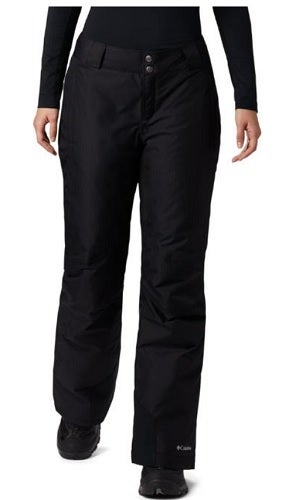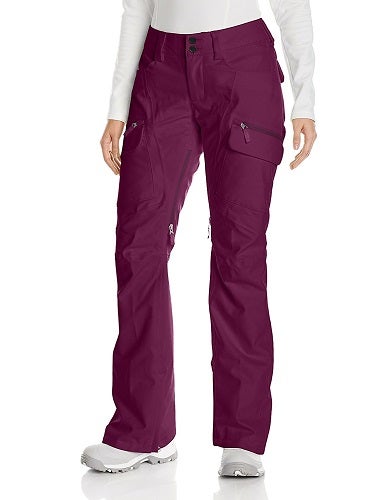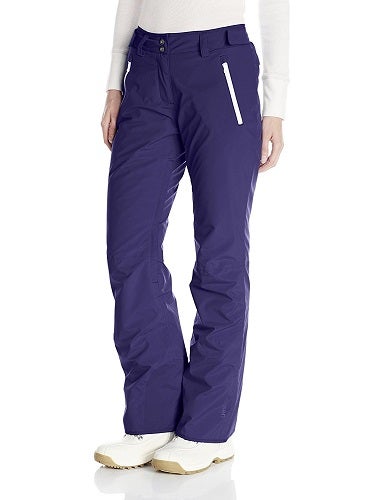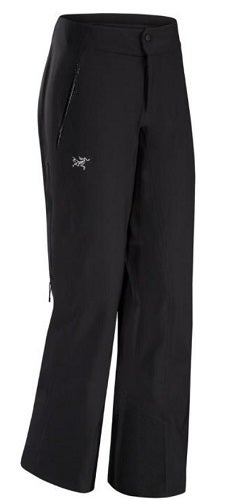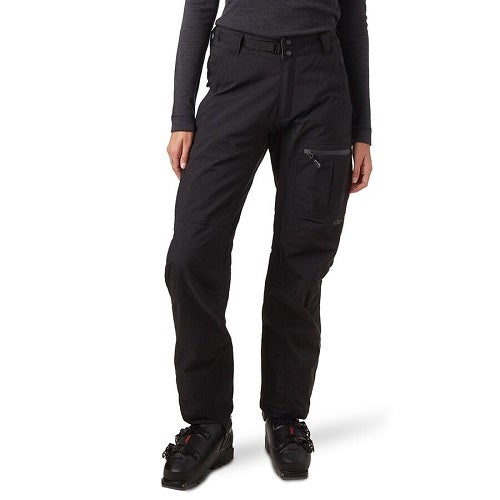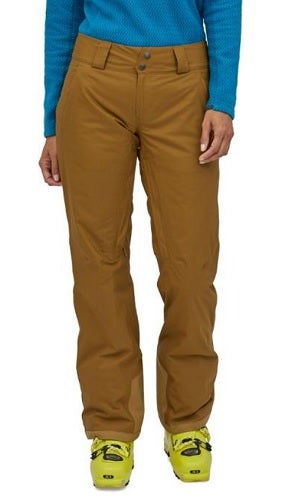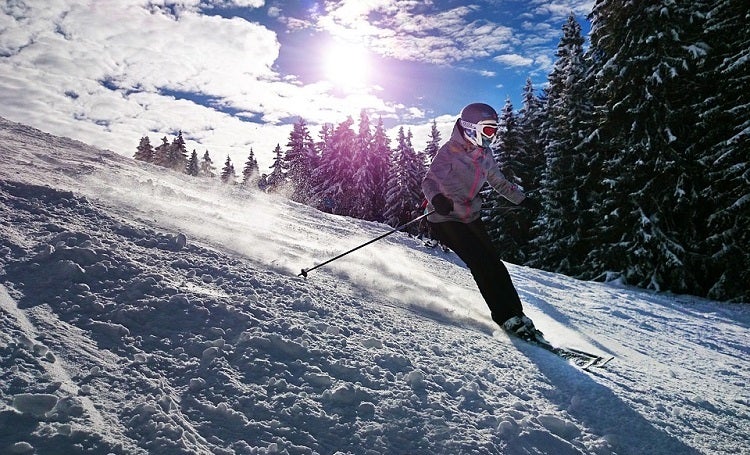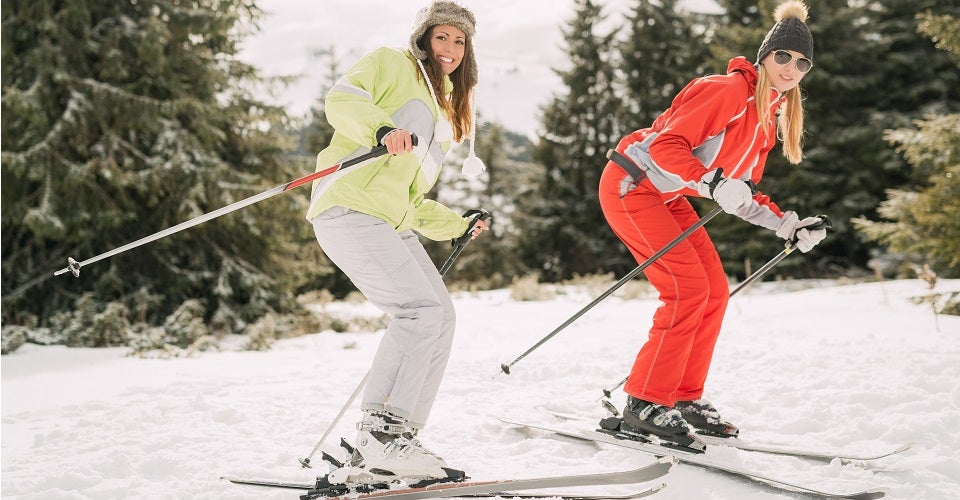
Our Editors independently research, test, and rate what we feel are the best products. We use affiliate links and may receive a small commission on purchases.
Ladies, are you looking for the best women’s ski pants? For better or worse, women’s clothing on the mountain tends to have some dedicated features.
Five years into my career as a ski instructor in the mountains of Utah, I know what gear belongs on the mountain and what doesn’t.
To help you choose, we put in the research to bring you what we feel are the top women’s ski pants. Now let’s find the right pair for you!
Best Ski Pants For Women
For more of my ski gear recommendations, have a look through these popular Outside Pursuits guide links: Women’s Ski Jackets, Women’s Ski Gloves and Ski Base Layers
Quick Answer: The 7 Best Rated Ski Pants For Women
- Columbia Women’s Bugaboo Pant
- Burton Women’s Gloria Pants
- Helly Hansen Women’s Legendary Ski Pant
- Arc’teryx Women’s Ravenna Ski Pant
- Arctix Women’s Insulated Ski Pant
- Outdoor Research Women’s Blackpowder Pants
- Spyder Women’s Me Gore-tex Ski Pant
Our reviews of the top rated women’s ski pants with our guide and comparison table will help you choose the right pair for you.
Women’s Ski Pants Reviews
#1 Columbia Women’s Bugaboo Pants
- Shell: Nylon twill
- Insulation: Polyester
- Seams: Fully taped seams
- Other: Zip-closed pockets
Columbia sportswear has been at the top of the list in my book on a price/performance basis. The Columbia Women’s Bugaboo Pant is definitely a shot in the right direction.
They have a durable 100% nylon shell that will take a lot of abuse. I would have like to have seen reinforcement patches to prevent cuts from your ski edges but that’s not a deal breaker.
They have Columbia’s well known “Omni-Tech” shell that is waterproof and breathable keeping you dry and comfortable on the slopes.
The seams are all taped providing extra waterproofing where it is most needed.
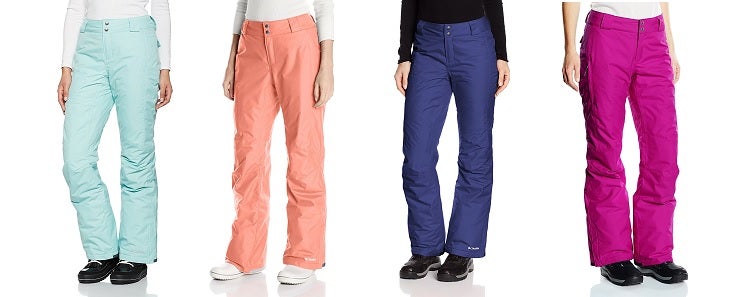
They have zippered side pockets and back pockets with flaps for plenty of storage for your phone or some snacks. The waist has the industry standard double Velcro with added belt loops if you need them.
As is critical, Columbia put integrated gaiters into these pants so we’re guaranteed that snow and cold will not get in through the bottom of the pants.
For someone who is budget minded but still wants a quality pair of ski pants, these are a good bet.
#2 Burton Women’s Gloria Snow Pants
- Shell: Dobby nylon shell
- Insulation: 85 Grams ThermaTech
- Seams: Fully taped seams
- Other: Zippered cargo pockets, Anti-Scuff Cuffs
Burton was founded by Jake Burton in Burlington Vermont have been making snowboards and apparel since the 70’s.
They are known for making quality outerwear and the Gloria Pants don’t disappoint.
The Gloria ski pants are bluesign approved with Burtons “DRYRIDE” shell that is waterproof and breathable rated at 10,000mm.
They have a bit of stretch to them so they have some give when you want to carve some turns.
The liners are soft with a taffeta lining to wick away moisture and feels comfortable next to your skin if you are not using a base layer.
The thighs have ventilation zippers when you need to release some heat if you are working up a sweat or the weather turns warm.
They are a 3 layer pair of pants, meaning they have a tricot membrane sandwiched between the liner and the shell. This helps with waterproofing and breathability.
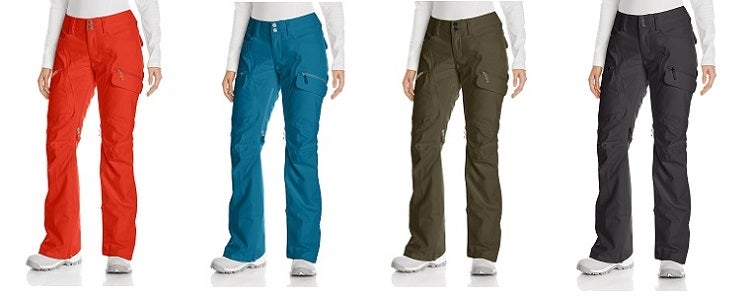
One feature I really like the inner-boot reinforcement patches and anti-scuff cuffs to prevent scraping the bottoms when you are walking through the parking lot.
They have large zippered cargo style pockets for plenty of storage. There a variety of colors available, one is sure to suite your style. These are probably the best women’s ski pants.
#3 Helly Hansen Women’s Legendary Ski Pants
- Shell: Polyester with DWR finish
- Insulation: PrimaLoft 60g
- Seams: Fully taped seams
- Other: Dual hand pockets and back pocket
Helly Hansen is based in Oslo Norway and has been making outdoor apparel since the 1870’s.
They are a relative newcomer in ski apparel but they have become known for making quality products and the Legendary Ski Pant is a solid option.
The shell is a 2ply Bluesign approved construction that stretches 2 ways giving you flexibility and comfort. They are fully seam sealed and have DWR (Durable Water Repellency) treatment for water resistance.
They also feature articulated knees for added comfort when on the slopes all day or sitting in the lodge for an Après drink.
These are an insulated pair of ski pants, with 60g of Helly Hanson’s “Primaloft” insulation. This is on the high side, making these a warm pair of ski pants.
For extra durability the bottom cuffs have been reinforced to prevent abrasion from walking through parking lots or other rough surfaces.
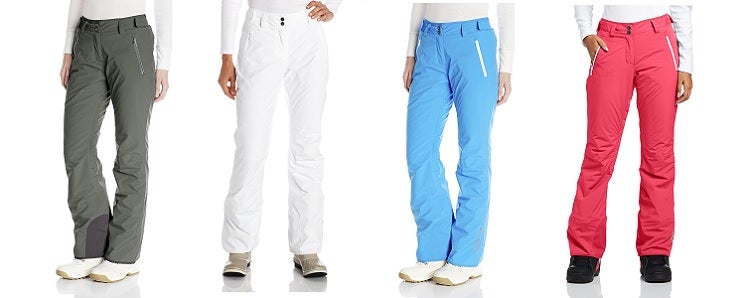
They have what I consider an absolute necessity, boot gaitors with a silicone layer to keep out the snow and cold. To top it off the pants also have inner thigh vents for releasing heat.
These are feature rich pair of ski pants and with the Helly Hansen name on them you know they will last you along time.
#4 Arc’teryx Women’s Ravenna Ski Pants
- Shell: Nylon with Gore-Tex
- Insulation: Lightly insulated liner
- Seams: Fully taped seams
- Other: 100D Cordura powder cuffs
Taking it up on the price and quality level are the Arc’teryx ski pants. These are what would be considered the “premium” category of ski pants.
For the price we get a pair a ski pants bristling with features.
These are designed from the ground up for a woman’s shape so they provide a comfortable fit. And with articulated knees plus a flannel like liner they are a comfortable pair of ski pants.
The have boot gaitors or what Arc’teryx calls “PowderCuffs” to keep out the snow and cold. Reinforced patches on the interior prevent cuts from your skis.
The hems at the bottom use “Cordura” to resist abrasion and tearing when walking over rough surfaces.
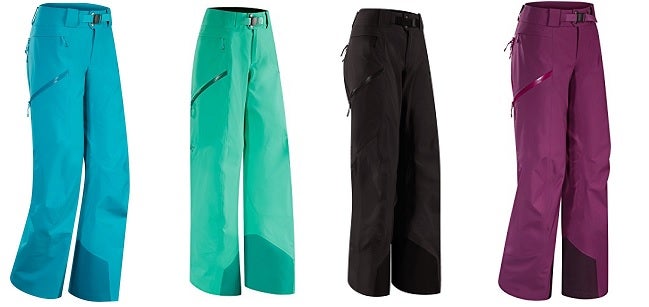
These are a lightly insulated pair of pants, so if the conditions are cold make sure to use a good base later to stay warm. All seams are taped for water resistance plus the zippers are water tight as well.
If the weather turns warm they also have ventilation zippers on the sides to release heat. The DWR finish (Durable Water Repellent) completes these pants to repel water and stains to keep tjem new looking for a long time.
Definitely on the higher end of the price spectrum, not only do they just look good they perform as well as you would expect for a pair of pants at this price point.
#5 Arctix Women’s Insulated Ski Pants
- Shell: Dobby nylon shell
- Insulation: 85 Grams ThermaTech
- Seams: Critical seam taped
- Other: Zippered hand warming pockets
Now we are on the budget end of the price spectrum with the Arctix ski pants.
These are among the most inexpensive pants on the market but still manage to deliver on performance.
They have 85grams of ThermaTech insulation so they are definitely a warm pair of pants. Slightly bulkier because of it however. If you’re really tearing up you will probably overheat in these pants.
Unfortunately at this price point they do not have zippers for ventilation. So keep that in mind before you buy them.
They are surprisingly breathable while providing water resistance. The critical seams are taped, so unless you are in very wet conditions you will still remain dry.
The shell is 100% nylon for durability and should give many ski seasons of use. Even at a bargain price they have boot gaitors and zippered pockets for secure storage of your phone or some snacks.
The Arctix ski pants are perfect for the skier on a budget and still wants a good pair of pants.
#6 Outdoor Research Women’s Blackpowder Pants
- Shell: Pertex Shield 2L 100% nylon
- Insulation: Polyester tricot
- Seams: Taped
- Other: 420D oxford scuff guard
Outdoor Research is one of my all-time favorite brands for outdoor gear.
Their equipment is made to great standards, they always seem to be ahead of the fashion curve, and I know I can recommend their products to anyone.
One of the better innovations in modern outdoor fabrics lately, in my view, has been stretch weaves.
With these waterproof ski pants, you’ll be able to really drive into those carves or tuck to stick a landing through the chutes without getting bound up.
As far as weatherproofness goes, the pants feature waterproof breathable layered construction. On the inside is lightweight polyester insulation for warmth. Each seam is 100% taped with waterproof seam sealer.
At the waist is a set of belt loops that are piggybacked by adjustable elastic.
This means you’ve got some flexibility in fitment for body size and shape (and whether or not you just ate at the lodge).
Best for those who want a forgiving modern pant with high-tier performance.
#7 Patagonia Women’s Stormstride Pants
- Shell: 75-denier polyester
- Insulation: 340g Thermogreen polyester
- Seams: Sealed
- Other: Waterproof H2No
Patagonia has come a long way since they first hit the scene here in the US.
Not only are their products here to stay, but they’re beginning to lead the pack with ski pants that are affordable, modern, and high-performance.
If you’re not the biggest fan of the high-speed, low-drag modern outdoor gear perhaps the touch of street fashion on these pants will fill your niche.
Patagonia has put in top-tier performance features such as waterproof seams and waterproof breathable H2No laminate.
They’ve also tipped the scales a bit more toward casual with features like the shiny Metaluxe zippered hand pockets and accented stitching that feels more like a pair of jeans than ski pants.
One feature I love that gets too often overlooked on other pants is the leg zips for thigh ventilation. If you are a backcountry skier you will appreciate the Embedded RECCO® reflector.
The polyester taffeta is a great heat and sweat management tool on the mountain that these pants deliver on!v
Women’s Ski Pants Comparison Table
| Women’s Ski Pants | Shell | Insulation | Seams | Other | |
|---|---|---|---|---|---|
| Columbia Women's Bugaboo Pants | Nylon twill | Polyester | Fully taped seams | Zip-closed pockets | |
| Burton Women's Gloria Pants | Dobby nylon shell | 85 Grams ThermaTech | Fully taped seams | Zippered cargo pockets, Anti-Scuff Cuffs | |
| Helly Hansen Women's Legendary Ski Pant | Polyester with DWR finish | PrimaLoft 60g | Fully taped seams | Dual hand pockets and back pocket | |
| Arc’teryx Women's Ravenna Ski Pant | 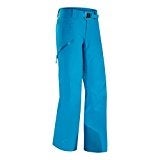 | Nylon with Gore-Tex | Lightly insulated liner | Fully taped seams | 100D Cordura powder cuffs |
| Arctix Women's Insulated Ski Pant | Dobby nylon shell | 85 Grams ThermaTech | Critical seam taped | Zippered hand warming pockets | |
| Outdoor Research Women's Blackpowder Pants | Pertex Shield 2L 100% nylon | Polyester tricot | Taped | 420D oxford scuff guard | |
| Patagonia Insulated Snowbelle Women's Ski Pants | 75-denier polyester | 340g Thermogreen polyester | Sealed | Waterproof H2No |
Author’s Expertise / Why You Should Trust Our Reviews
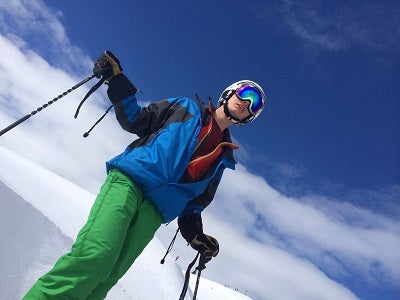
I started writing online for my own outdoor sports blog in 2010. Right out of the gate I landed opportunities to test gear for Road ID, Hydrapak, Wolverine, Helle Knives, Pearl Izumi, and GU Energy. Those were the days when growing a no-name blog was easy. Today niche blogging is a different story.
In 2012 I left Central Wyoming College with a degree in Outdoor Education and Leadership. Soon after, I was on a month-long expedition with the National Outdoor Leadership School’s Outdoor Educator Course which helps would-be outdoor guides ascend from “aspiring” to “inspiring”.
Between here and there I’ve participated in and spoken at length about outdoor pro-deal programs for companies like Patagonia, Smith Optics, Giro, Therm-a-Rest, Platypus, MSR, Columbia, and many more. I still work closely with tons of outdoor gear companies to review and analyze products. If you have a product opportunity you’d like to discuss, please review my guidelines and contact me here.
After several seasons of guiding backpacking trips and working as a certified Alpine Ski Instructor at Deer Valley Resort in Park City, UT for several seasons, I had to move on. As any educator will tell you – teaching doesn’t pay the bills very well.
In 2016 I began building my freelance writing career as readers and other bloggers reached out to me for help with technical outdoor sports content strategy for online businesses. Within weeks I was overloaded with requests for freelance writing and my new career blossomed.
2018 saw the launch of Hike With Less, my ultralight backpacking partnership program with Dustin Walker.
How to Choose the Best Women’s Ski Pants – Buyers Guide
- Ski Pants Fit
- Types of Women’s Ski Pants
- Pockets
- Gaiters
- Waterproofing
- Venting and Zippers
- Reinforcements
- Belts and Snaps
- FAQs For Women’s Ski Pants
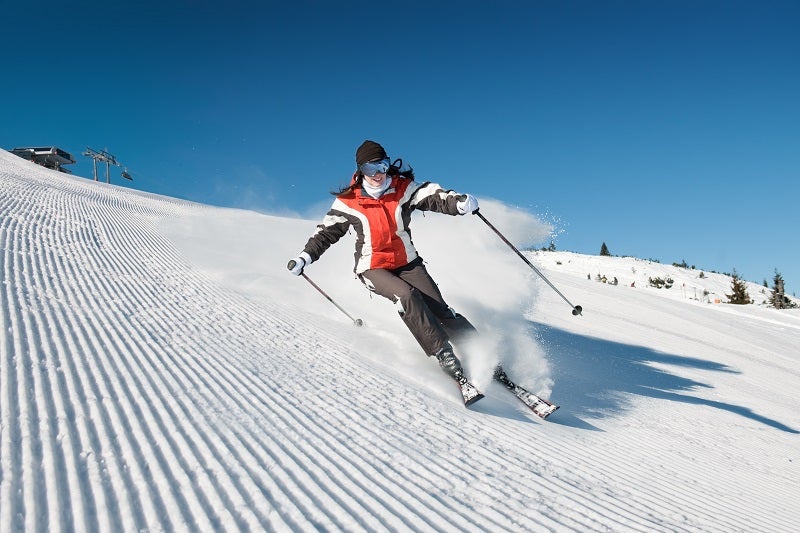
Ski Pants Fit
By some unspoken agreement, ski outerwear designers have been constricting ladies’ pants like a slow paced boa constrictor. It’s common now to see women on the slopes with near yoga pants tight ski outerwear.
While there’s nothing inherently wrong with this, it’s something I think ladies should consider before making a buying decision.
Why?
Because these tight ski pants, in many cases, are so tight that they restrict movement and insulation. With such tight fabric it’s hard for your legging and base layers to keep you warm on those nasty days!
Plus, there’s nothing more annoying than getting bound up by your clothing when you’re trying to absorb and rip those bumps.
Now, don’t let me fully dissuade you from fashionable tight fitting ski pants. If you’re skiing extremely mellow terrain and the weather is guaranteed to be pleasant, there may be no reason to worry.
Types of Women’s Ski Pants
We’re going to cover the types of ski pants here so you can make a good decision on what type of ski pants are right for you!
Uninsulated Pants
Uninsulated ski pants, aka shells, are usually a waterproof / windproof outer layer that is meant to be worn as part of a layering system.
Most often shells are made, primarily from an outer layer of thick nylon. Nylon is durable and abrasion resistant so that your pants don’t immediately rip when you take your first digger or brush against some branches.
You can further break down the uninsulated ski pants into two sub categories; 2-layer pants and 3-layer pants.
In the 2 layer variety you have just a breathable liner with a water resistant shell, whereas 3 layer pants have a water resistant and breathable “membrane” in between the shell and liner. This hybrid system gives you the best of both worlds.
Naturally they are more expensive than 2 layer pants.
I am of the opinion the extra layer isn’t necessary. A good 2 layer pair of pants are fine and much cheaper.
Pro tip: look for reinforced nylon patches on the inside of each pant leg where your boots and ski edges are likely to rub. This will prevent your skis from cutting your pants, definitely a nice feature!
Some uninsulated ski pants come with a very bare minimum layer of fleece or some other polyester based “insulation” for just a touch of warmth.
Keep an eye out for leg zips, inner leg zippers which can be opened and closed to manage heat levels during changes in temperature to prevent overheating. This is a “must” have in my book!
Make sure you buy a size of pant which allows plenty of space for adding layers of insulation underneath when the mercury drops.
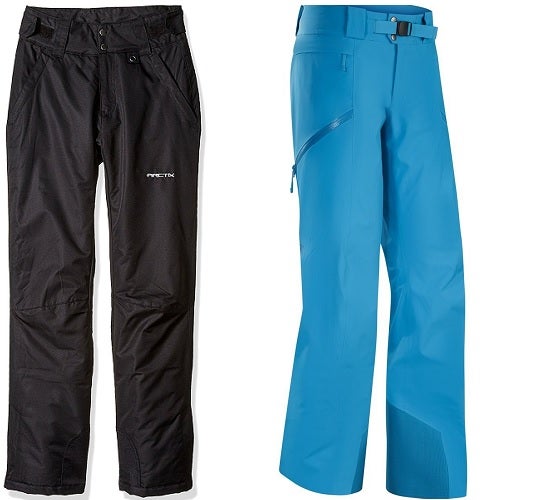
Insulated Ski Pants
Most women who get into skiing assume insulated ski pants are the way to go. However, this is not necessarily a good idea.
They are the least versatile type of pants and unless you are only making a few runs down the mountain or only ski in very cold weather, thickly insulated ski pants may not be the way to go.
I can’t remember my legs ever getting cold on the slopes. While I usually ski pretty hard, even when I am skiing with my girlfriend who is much slower I still have never had an issue with uninsulated pants with a base layer underneath, (see my recommended base layers here).
Insulated pants come in many thicknesses and intended warmth ratings. These pants can range from bare minimum insulation to polar-explorer style insulation.
The single biggest drawback of most insulated pants is their inherent difficulty in modifying warmth levels based on activity level. If you’re ripping it down the double blacks you’re going to want less insulation than when you’re sitting down for the afternoon beer on the patio.
As with the shell pants, you’ll want to look for insulated pants with ventilation options, it will be critical for temperature regulation.
When it comes to insulated pants you’ll want to be very thoughtful about your normal activity levels while skiing. If you’re a slower skier who only skies a couple runs per day then you’ll be okay with a heavier insulation.
I have a good pair of The North Face Freedom Ski Pants that are lightly insulated and on especially cold days on the ski lift I am glad I have them!
If you’re going down run after run down the bumps, you’re going to overheat quickly with insulated pants.
If you go with the insulated variety, go for a light insulation, like 40-60 grams, this way on the really cold days, just wear a good base layer and you should be fine.
Softshell Pants
Like jackets, there is a “softshell” type of pants offered as well. The main difference is that soft shell ski pants don’t have the durable, nylon outer shell and use a lighter, more flexible material.
These pants are primarily designed for warmer weather where you don’t need protection from the cold wind.
They are more comfortable and breathable than the “hard shell” variety. If you are a beginner skier, these are probably not for you.
They do not offer much in the way of water resistance and if you are falling, you are quickly going to get wet and miserable. For the spring skier in the warmer weather, these are a solid option.
Bibs
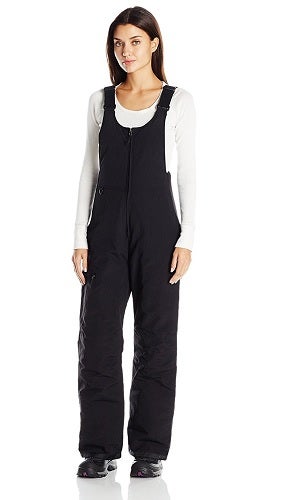
Bibs take the pants game to the next level. Over the shoulder straps hold these chest-high pants in place while you ski.
These type of ski pants are an excellent option for the deep powder skier and the back country or heli-skier who needs the ultimate protection from snow getting down your pants.
Bibs can be expensive than ski pants but they have two solid benefits:
- They stay in place more securely
- There is no waistline where snow can sneak in
It’s important with bibs that you get the correct size. If they straps don’t allow the bibs to sit low enough they will ride up your crotch making for a uncomfortable day on the slopes.
Good ski bibs offer a hybrid design that allow you to zip off the “bib” part and left with a pair of pants only. I like this design as it offers the best of both worlds.
Ski bibs are the best option for deep powder skiers or skiers who feel that ski pants won’t stay in place for them.
Pockets
Hmmm… to pocket or not to pocket? That’s the question this time around.
When skiing I hate having stuff in my front pockets. It gets in the way when I’m moving through the steeps and bumps. There are a few exceptions, however.
With larger or deeper front pockets I don’t mind keeping a few items in there. Come chapstick and maybe my wallet (if it’s not too bulky) can be okay. But over a 6 hour day of ripping the mountain, stuff in your pockets can pinch, rub, and annoy you to no end!
That’s why I prefer cargo pockets. They’re handy in case you need a place to stash a trail map, an extra layer, or some gloves. You can never have too much backup storage on the mountain!
Rear pockets are also nice but good luck finding them on ladies’ pants. The back of women’s pants seems to be precious real estate reserved by designers exclusively for visual appeal these days.
With already tight fitting pants, be careful about the location and contents of pockets. It sucks to have your phone or keys binding against your legs while you’re trying to move freely on the mountain!
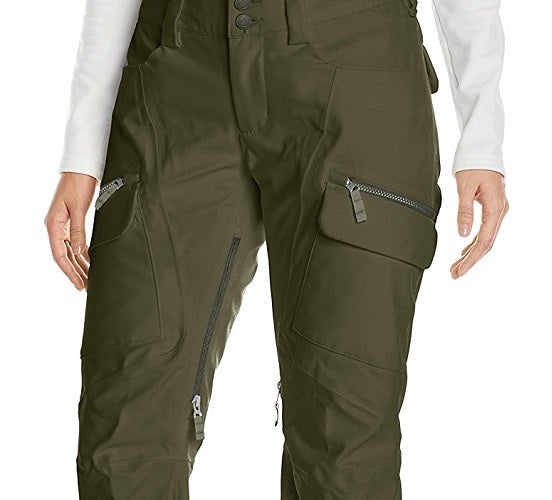
Gaiters
Built in gaiters are almost guaranteed these days when you purchase ski pants. If you’re not aware, gaiters are the parts that come down over your ski boot and keep snow out of your legs and boots!
If you suspect that the pants you’re investigating don’t have gaiters, just leave them. They’re not worth buying.
Good gaiters should have a snap or velcro to open up. You then roll up the gaiters, put on your ski boot, and then roll the gaiter down over the top and snap it closed.
Most gaiters also have silicone or something sticky to keep the gaiter from riding up while you ski.
Waterproofing
Waterproof ski pants are usually a must-have. I would argue, however, that isn’t necessarily the case all the time.
For confident intermediate or expert skiers who don’t spend much or any time falling in the snow, there’s usually no reason to worry. However, early and late season conditions with freezing rain (or rain) and sloppy snow may call for waterproof pants.
Most skiers want, and feel more confident, with waterproof pants though. That’s fine! I usually ski with waterproof pants myself. But what kind of waterproof fabric makes the most sense?
Waterproof breathable garments are often touted as the best options on the market. They’re expensive but allow some water vapor to escape as you ski to help reduce sweat buildup. Many skiers prefer this style of waterproofing.
However, there’s a much more affordable alternative that I think you’ll love. I prefer the much cheaper non-breathable waterproof pants. But how do you avoid getting sweaty and gross? There’s a secret I’m about to tell you!
Venting and Zippers
The best women’s ski pants, in my world, are those with inner leg vents. These zippers open up mesh covered openings on the inner legs of your pants. Once open, the cool winter air does a great job of regulating temperatures and moisture in the pants.
Worried about modesty? Not a problem. Most skiers wear leggings under their pants, so even if someone sneaks a peak, they’ll just see your leggings. If it’s too warm for leggings, there’s not much to worry about.
Use the vents half-zipped and remember they’re between your legs anyways so it’s very unlikely to be visually noticeable anyways.
Vents are the saving grace of good ski pants and I would personally pay top dollar for this feature. In my opinion every other ski pant feature takes backseat comparatively.
Reinforcements
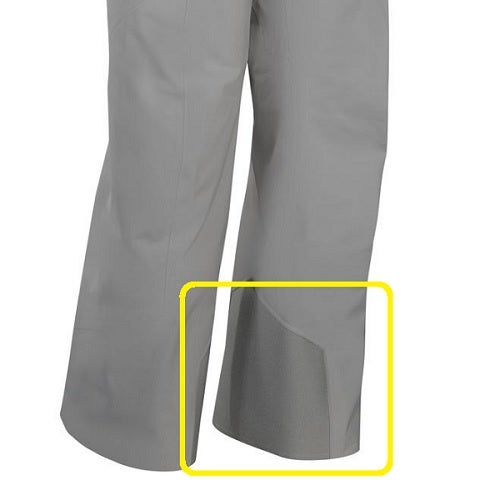
Ski edges are sharp or at least they should be (you have had your skis tuned this season, haven’t you???). Plus the hard plastic and metal of boots and buckles can do some serious damage to the lower pants.
So how do you protect your often expensive ski pants investment?
It’s simple – look for ski pants with reinforced boot patches. These sturdy, durable, patches of fabric are located on the inside of each pant leg. They resist abrasion and cuts from ski edges very well.
I’ve put well over 100 days a season on my ski pants over the last 5 years and these durable patches are only just beginning to wear out.
Most people don’t ski nearly that much, so you shouldn’t need to worry about durability as long as you choose ski pants with good cuff and boot reinforcement!
Belts and Snaps
Fastening your ski pants at the beginning of the day is easy! After a heavy lunch as you launch into the steep bumps of the chutes it might be a different story, though.
When I look for ski pants, I’m always on the hunt for double snaps and an integrated belt. Of course, you may not always find both features.
Many ski pants have adjustable elastic waistbands that allows for movement on the fly. Based on how many layers you’re wearing and how you’re feeling that day you can open or close some of the waist of the pants.
If you have trouble finding pants that fit well, you can consider bibs or overall style ski pants. These are common and many skiers prefer the secure fit and high waist to keep out snow on the fly!
FAQ About Women’s Ski Pants
Q: What’s the difference between loose fit and slim fit ski pants?
A: There’s a huge tendency right now in women’s ski pants to make them fit like leggings. Sure, it looks good and fashionable, but is it practical?
Well, I have to say that I’ve never worn skin tight women’s ski pants so I’m speaking from a perspective of a professional ski instructor and not a woman’s perspective. That said, however, here’s all I can help you with…
Generally insulation in outdoor clothing is achieved by trapping dead air between layers of clothing. When your outer layer (ski pants) are tight against the skin, there is very little room for warm air to be trapped.
Usually the best way to stay warm is to use a skin tight under layer of leggings which add warmth and wick away some moisture. Over that a looser pair of pants keeps water and wind from sapping away that warm pocket of air around your legs.
When we wear a tight outer layer it defeats this combination purpose and leaves us with a lot less insulation.
That said, as long as those tight(er) ski pants are wind and waterproof they’re going to help a lot over nothing at all. Plus, many of them have some insulation built in.
In the end, however, they’re never going to be “technically” as warm as some other options might be.
Q: What should I be wearing underneath my ski pants?
A: I usually suggest that people wear either lightweight or midweight leggings under their ski pants. If you’re skiing hard, go with lightweight, if you’re not working as hard, go with a midweight legging.
Skin contact with most ski pants is just uncomfortable so leggings provide moisture management (sweat) as well as warmth and comfort. Then you can adjust and control your temperature by using leg vents on your ski pants (which I highly recommend).
Q: Do I need pockets on my ski pants?
A: Ladies know as well as anyone that women’s clothing tends to lack pockets. In the case of ski pants the lack of pockets is probably for the best.
When I get out skiing I try not to store anything at all in my pants. Even if they have pockets I usually store my gear in my coat and not my pants.
Why avoid storing gear in your ski pants?
Because when you’re skiing hard and really cranking down into you skis (advanced and expert skiers usually) your legs can be maxed out. You don’t want keys or phones binding in your pockets as you drop the hip and crank those ski edges up to rip a line.
Beginner skiers probably need not worry so much about these details and can more easily get away with storing stuff in pants pockets.
Q: What’s the story with bell-bottom ski pants?
A: Women’s fashion is a topic I most certainly won’t pretend to understand. The simple fact is that bell bottom ski pants seem to be making a small comeback. But should you be wearing them?
Kind of like the whole “pockets on ski pants” topic, I can only approach this from a relatively sterile standpoint.
Fine motor control of the edging and rotary movements involved in good skiing demands perfect dexterity of each ski boot. At high speeds, when you’re really ripping lines down the mountain, those sharp ski edges and boot buckles can and will get thrashed around.
The last thing you want is to hit a bump and have your binding, buckles, or ski edges get momentarily caught up in the fabric of a bell bottom pant leg. This is going to result in a high speed wipe-out instantly.
Not to mention skiing off trail means skiing through brush, sticks, and sometimes little saplings (usually on accident). It just happens. Who wants to get their pant leg caught on a branch? Not me!
Fashion aside, bell bottom pants for skiing are probably not the best technical choice.
Q: Do I go with waterproof and/or breathable pants?
A: Always go with waterproof ski pants. That’s just my two cents.
Breathable pants aren’t really necessary and they cost a ton. I just recommend people avoid them.
Instead, look for ski pants with zippered leg vents. These allow a lot better control of temperature and moisture inside your pants as you ski through various conditions.
A good pair of waterproof (non-breathable) ski pants with leg vents will cost you half or less than breathable pants and they’ll get you a lifetime of use. No need to overthink it.
How We Researched
To come up with the top skiing pants for women we researched a variety of sources for reviews such as REI, Backcountry, Moosejaw, EVO along with our own personal experience.
We also consulted online magazines for product research and reviews to get as much unbiased information as we could. To help weed out fake reviews we used Fakespot.com to make sure we only looked at genuine reviews.
With so much quality gear available, we had to narrow it down based on what we felt were the best options were for the price.
The author, Casey Fiedler was a full time ski instructor for Park City and The Canyons in Utah. To help narrow down the selection he used his personal experience along with recommendations from fellow ski instructors.
After extensive research, we came up with our list to help you choose the right pair for you.
Sources
Skimag.comI hope this guide was helpful for finding a good pair of women’s ski pants to fit your needs. If you want to comment or recommend a pair of pants I didn’t include, please use my contact form to get in touch.
New to skiing? See my beginners guide to skiing for tips and advice.
If your looking for a good pair of goggles, please see my favorite pairs here.
Have fun and be safe out there!

